Annona squamosa L. (custard apple or sugar apple), belonging to the Annonaceae family, is a small tree or shrub that grows natively in subtropical and tropical regions. Seeds of the custard apple have been employed in folk medicines because of the presence of bioactive chemicals/compounds such as alkaloids, flavonoids and phenolic compounds and acetogenins and cyclopeptides that are responsible for various biological activities. The seeds also show the presence of tannins, vitamin C, vitamin E and a higher content of amino acids. From investigations, it has been shown that the seeds of A. squamosa have considerable potential to be used as an antibacterial, hepatoprotective, antioxidant and antitumor/anticancer agent. Cyclosquamosin B, extracted from the custard apple seed, possesses vasorelaxant properties. Tocopherols and fatty acids, notably oleic acid and linoleic acid, are also found in the seed oil. A. squamosa seeds contain a high amount of annonaceous acetogenins compounds, which are potent mitochondrial complex I inhibitors and have high cytotoxicity. A survey primarily based on the nutritional, phytochemical and biological properties showed that A. squamosa seeds can be used for the discovery of novel products, including pharmaceutical drugs.
- custard apple seed
- health benefits
- bioactivities
- phytochemistry
- anticancer
1. Introduction
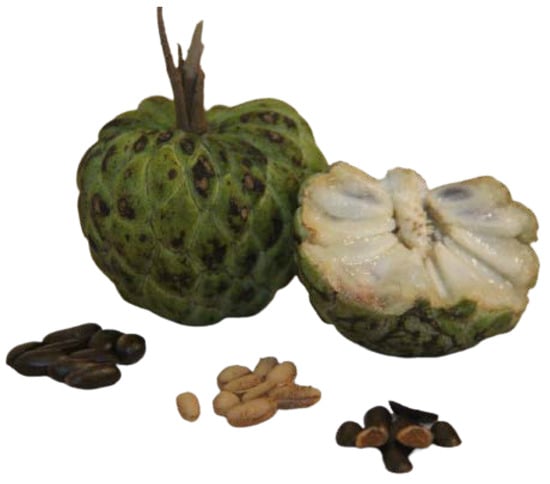
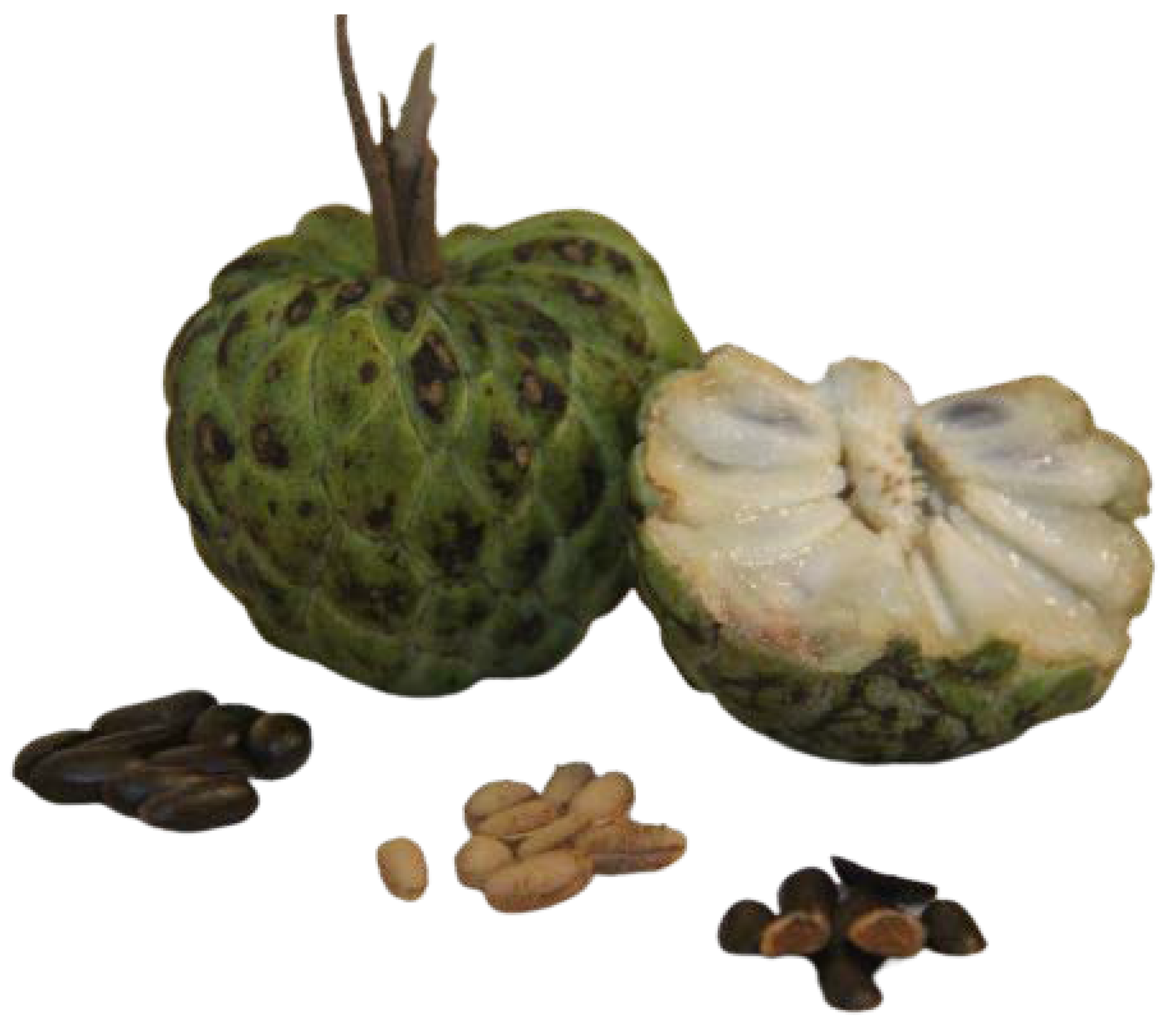
2. Proximate Composition of Custard Apple Seeds
|
Variety |
Category |
Compound |
Yield/Concentration |
Ref. |
||||||
|---|---|---|---|---|---|---|---|---|---|---|
|
Annona squamosa seeds |
Fatty acids (%) |
Antimicrobial Margaric acid |
Chloroform extract of seeds (10–60 μg/mL) 0.2 |
E. coli, S. typhi, K. pnemoniae, P. mirabilis, | ||||||
B. subtilis | , | S. aureus |
Significant antibacterial activity with inhibition rate of 37–56, 40–60.75, 36–64, 48.5–63, 35–53.5 and 34–47% for K. pneumoniae, B. subtilis, E. coli, P. mirabilis, S. typhi and S. aureus |
Linoleic acid |
||||||
|
Annona squamosa seeds |
22.9 |
|||||||||
(Nashik, Maharashtra) |
Antimicrobial |
Petroleum ether, methanol and chloroform seed extract |
E. coli, P. aeruginosa, S. aureus, K. pneumoniae, B. subtilis |
PEE: highest growth inhibition rate was observed for S. aureus (ZOI: 12 mm) and lowest for P. aeruginosa with (ZOI 7.8 mm); ME: significant inhibition against K. pneumoniae (ZOI: 12.8 mm) and B. subtilis (ZOI: 9.2 mm); CE: inhibition against E. coli (ZOI: 14.8 mm) and B. subtilis (ZOI: 1.7 mm) |
Eicosanoic acid |
|||||
|
Annona squamosa seeds |
0.9 |
|||||||||
(Jayanagar, Bangalore) |
Antimicrobial |
Methanolic seed extract (50 mg/mL) |
E. coli, S. typhi, S. aeurus, E. faecalis, P. aeruginosa, S. paratyphi, K. pneumoniae |
Inhibits growth of bacterial strains with ZOI equal to 27–30 mm for E. coli, 31 mm for S. typhi, 27–32 mm for S. aeurus, 23 mm for E. faecalis, 22–24 mm for P. aeruginosa, 22–30 mm for S. paratyphi, 11–20 mm for K. pneumoniae |
Palmitic acid |
|||||
|
Annona squamosa seeds (Bangalore) |
12.1 |
|||||||||
|
Antimicrobial |
Methanolic seed extracts of A. squamosa and Prunus Persia (1:2) |
S. aureus, E. coli, K. pneumoniae, S. typhi, Enterococcus faecalis, P. aeruginosa, S. paratyphi |
ZOI ranges between 18–34 mm for all tested pathogens |
Heneicosanoic acid |
2.3 |
|||||
|
Annona squamosa seeds (Alexandria, Egypt) |
Antimicrobial |
- |
E. coli, C. albicans, B. subtilis, K. pneumoniae, S. senftenberg, S. aureus |
ZOI ranging between 9.50, 9.53, 10.33, 12.30 6.50 and 12.50 mm against E. coli, C. albicans, K. pneumoniae, S. senftenberg, S. aureus and B. subtilis, respectively |
Stearic acid |
13.6 |
||||
|
Annona squamosa seeds |
Antimicrobial |
Aqueous seed extract (500 and 1000 mg pm- CuO NPs) |
Xanthomonas oryzae |
At 500 mg: ZOI = 9 mm; at 1000 mg: ZOI = 15 mm |
Oleic acid |
47.4 |
||||
|
Annona squamosa seeds (Nam Dinh, Vietnam) |
Antifungal |
Acetogenins (squamostatin-A (7), squamocin-G (5), and squamocin (8)) extracted from custard apple seeds |
Phytophthora infestans |
Acetogenins exhibit dose-dependent activity against the growth of zoospore and sporangium IC50 value for inhibition of sporangium germination was 1.24–2.09 μg/mL and IC50 value for zoospore germination inhibition was 1.89–3.05 μg/mL, for all acetogenins |
11-eicosanoic acid |
0.2 |
||||
|
Annona squamosa seeds |
Antidiabetic |
Ethanolic and methanolic seed extract (200 mg/kg BW) |
Alloxan-induced diabetic rats |
Decrease in level of blood glucose after administration of ethanolic seed extract (139.8–142 mg/dL) and methanolic seed extract (139–146 mg/dL) at 7th day of treatment |
Dihydrosterculic acid |
0.1 |
||||
|
Annona squamosa seeds |
Anti-inflammatory |
Cyclopeptides-met-cherimolacyclopeptide and cyclosquamosin D (A1), and B (B) |
LPS-J774A.1 cell line |
Reduction in IL-6 and TNF-α secretion in J774A with an IC50 value of 1.22 and 9.2 µM |
17-Methyloctadecanoic acid |
|||||
|
Annona squamosa seeds (Luye, Taitung County, Taiwan) |
0.1 |
|||||||||
Anti-inflammatory |
Cyclosquamosin D |
Lipopolysaccharide and Pam3Cys-stimulated J774A.1 macrophages |
Inhibition of secretion of pro-inflammatory cytokines |
Palmitoleic acid |
||||||
|
Annona squamosa seeds (Jiangsu, China) |
0.01 |
|||||||||
Antitumor |
Bullatacin and 12,15-cis-squamostatin-A |
A-549, Hela, HepG2 and MCF-7 (in vitro) and H22 tumor cell line in mice (in vivo) |
IC50 value for MCF-7, A-549, and HepG2 and Hela, are 2.5 × 10−1, 3.2, 3.6 × 10−1 and 13.0 µg/mL, respectively, and 69.55% inhibition of H22 cell line |
[18] |
Annona squamosa seeds |
|||||
|
Annona squamosa seeds (Jiangsu, China) |
Amino acids (g/100 g protein) |
Leucine |
0.845 |
Antitumor |
[22 |
Seed oil |
H22 tumor cell line (mice: in vivo) | ][21] |
||
Inhibition of growth of H | 22 | cell line with maximum inhibitory rate of 53.54% |
Isoleucine |
0.464 |
||||||
|
Annona squamosa seeds (TaiDong County, Taiwan) |
Antitumor |
Squadiolins A and B and squafosacin B |
MDA-MB-231, Hep G2, MCF-7 and Hep 3B, cell lines |
Squadiolins A- MDA-MB-231: IC50 = 0.63 µM; squadiolins B- MDA-MB-231: IC50 = 0.28 µM; squafosacin B- HepG2: IC50 = 0.71 µM; Hep 3B: IC50 = 0.72 µM; MCF-7: IC50 = 0.96 µM |
Glutamic acid |
|||||
|
Annona squamosa seeds (Hyderabad, India) |
0.995 |
|||||||||
Antitumor |
Aqueous and organic extract from defatted seeds |
AK-5 histiocytic tumor cell line in rat animal model |
Significant tumor cell apoptosis, with increased caspase-3 expression, down regulation of Bcl-2 and Bclxl antiapoptotic genes |
[11] |
Phenylalanine + Tyrosine |
|||||
|
Annona squamosa seeds (Beijing, China) |
0.671 |
|||||||||
|
Anticancer |
Seed oil nanoparticles |
4T1-Mouse breast cancer cells |
Inhibitory rate of 69.8% against 4T1 cell line |
Aspartic acid |
||||||
|
Annona squamosa seeds |
0.684 |
|||||||||
Anticancer |
Ethanolic seed extract |
MCF-7 breast cancer cell line |
Inhibit growth of MCF-7 (IC50 = 10 ug/mL) by inducing apoptosis |
Serine |
||||||
|
Annona squamosa seeds (Alexandria, Egypt) |
0.299 |
|||||||||
Anticancer |
- |
HepG-2, MCF-7, Caco-2 and PC-3 cancer cell lines |
Caco-2: IC50 = 11.55 μg/mL; HepG-2: IC50 = 7.99 μg/mL; MCF-7: IC50 = 14.34 μg/mL; PC-3: IC50 = 7.31 μg/mL |
Alanine |
||||||
|
Annona squamosa seeds (Ahmedabad, India) |
0.594 |
|||||||||
|
Antioxidant |
Hexane, acetone, chloroform: methanol (2:1), ethanol (50%) and water seed extract |
DPPH assay |
Highest antioxidant activity was observed in water (777.64 g GAE/g), while lowest was observed in hexane (268.75 g GAE/g) seed extract |
Methionine + Cystine |
||||||
|
Annona squamosa seeds (Alexandria, Egypt) |
0.106 |
|||||||||
Antioxidant |
- |
DPPH assay |
IC50 value equal to 7.88 µg/mL |
Histidine |
||||||
|
Annona squamosa seeds (Ceara, Brazil) |
0.139 |
|||||||||
|
Antioxidant |
Methanolic seed extract |
Fe3+ reduction, DPPH and ABTS assay |
IC50 value of 0.57, 0.36, and 0.14 mg/mL for Fe3+ reduction, DPPH and ABTS assay performed on methanolic seed extract, respectively |
Arginine |
||||||
|
Annona squamosa seeds (Southeastern Brazil) |
0.704 |
|||||||||
|
Antioxidant |
Ethanolic seed extract |
DPPH assay |
EC50 value of seed extract is 63.19 µg/mL |
Glycine |
0.392 |
|||||
|
Annona squamosa seeds (Lucknow, India) |
Antioxidant |
Ethanolic seed extract |
Alcohol-induced liver damage in Sprague Dawley rats (150–210 g) (dose: 200 and 400 mg/kg po) |
Significant elevation in the level of SOD, GSH and CAT and decrease in the level of TBARS |
Valine |
|||||
|
Annona squamosa seeds (Lucknow, India) |
0.642 |
|||||||||
|
Hepatoprotective |
Ethanolic seed extract |
Alcohol-induced liver injury in Sprague Dawley rats (150–210 g) (dose: 200 and 400 mg/kg po) |
Reduction in ALT, ALP, AST, LDH and SBL and cholesterol level and increase in the level of albumin (p < 0.01–p < 0.001) and total protein (p < 0.05–p < 0.001) |
Threonine |
||||||
|
Annona squamosa seeds (Bangalore, India) |
0.324 |
|||||||||
Hepatoprotective |
Hydroalcoholic seed extract |
CCl4-induced hepatotoxicity in rats |
Reduction in the level of SGOT (51.22–87.37 U/L), SGPT (38.21–96.22 U/L), ALP (98.28–159.25 U/L) and total bilirubin (0.71–1.47 mg/dL) |
Lysine |
||||||
|
Annona squamosa seeds (Mumbai, India) |
0.407 |
|||||||||
Antipsoriatic/antiproliferative |
Seed oil |
HaCaT cell line in Oxazolone-induced psoriasis in female Balb/C |
Inhibition of growth of HaCaT cells |
[19] |
Annona squamosa seeds |
Polysaccharides |
Rhamnose, Fucose, Mannose, Fructose, Arabinose, Galactose, Fructosamine, Galactosamine, Xylose, Glucose, Glucosamine, and Mannuronic, Alluronic, Glucuronic and Galacturonic acid |
USP = 0.67–1.27%; FSP = 2.82–3.72% |
[27 | |
|
Annona squamosa seeds (Madhya Pradesh, India) | ] | [ |
Antithyroidal | 26] |
||||||
Methanolic seed extract (dose: 200 mg/kg) |
L-T4 (0.5 mg/kg/day) caused hyperthyroid in rats |
After treating T4-induced hyperthyroid mice with seed extract (200 mg/kg) for 10 days, the effects of L-T4 were reversed, demonstrating the potential of custard apple seed in controlling hyperthyroidism |
Annona squamosa seeds |
Carbohydrates (g/100 g DW (%)) |
||||||
|
Annona squamosa seeds |
Vasorelaxant |
- |
66.64 |
|||||||
Cyclosquamosin B |
Rat animal model |
Inhibitory effect on Ca2+ channel, at concentration of 10−5 M |
Fat (g/100 g DW (%)) |
|||||||
|
Annona squamosa seeds |
- |
Antiheadlice 29.21 |
||||||||
Petroleum ether seed extract |
In vitro |
Petroleum ether extract along with coconut oil (1:1), kills 90% of lice |
Fiber (g/100 g DW (%)) |
|||||||
|
Annona squamosa seeds (Pak Chong, Thailand) |
- |
32.64 |
||||||||
Antiheadlice |
Hexane seed extract |
In vitro against headlice |
Seed extract contains oleic acid and a triglyceride with one oleate ester that kills lice in 11–49 min |
Ash (g/100 g DW (%)) |
||||||
|
Annona squamosa seeds |
- |
Antihelminthic 1.90 |
||||||||
- |
- |
Seed extract exhibit antihelminthic activity against Pheritima posthuman and Haemonchus contortus |
Protein (g/100 g DW (%)) |
|||||||
|
Annona squamosa seeds (Fortaleza, Brazil) |
- |
2.25 |
||||||||
Antihelminthic |
Ethyl acetate seed extract |
Haemonchus contortus |
C37 trihydroxy adjacent bis- tetrahydrofuran acetogenin repressed egg hatching of H. contortus at 25 mg mL−1 |
Moisture (g/100 g DW (%)) |
||||||
|
Annona squamosa seeds |
- |
Antilarval 3.92 |
||||||||
|
Minerals (mg/kg) |
K |
56.47–355.84 |
||||||||
[ | ] | [ | 67] |
Ca |
46.90–187.12 |
|||||
|
P |
33.30–32.75 |
|||||||||
|
Mg |
16.22–20.36 |
|||||||||
|
Fe |
6.74–20.84 |
|||||||||
|
Cu |
0.30–23.91 |
|||||||||
|
Na |
9.29–28.27 |
|||||||||
|
Zn |
0.43–22.17 |
|||||||||
|
Mn |
0.25 |
|||||||||
|
Annona squamosa seeds |
Crude protein (%) |
18.34 |
||||||||
|
Crude fiber (%) |
17.56 |
|||||||||
|
Crude oil (%) |
30.41 |
|||||||||
|
Total carbohydrates (%) |
21.80 |
|||||||||
|
Moisture (%) |
6.65 |
|||||||||
|
Ash (%) |
5.24 |
|||||||||
|
Annona squamosa seeds |
Moisture (%) |
6.7 |
||||||||
|
Fat (%) |
26.8 |
|||||||||
|
Protein (%) |
17.5 |
|||||||||
|
Ash (%) |
2.2 |
|||||||||
|
Fiber (%) |
16.8 |
|||||||||
|
Tocopherol (mg/100 g) |
15.5–16.6 |
|||||||||
|
Annona squamosa seeds |
Carotenoids (μg of β-Carotene/100 mg) |
0.45 |
||||||||
|
Vitamin C (mg AA/100 g) |
0.57 |
|||||||||
DW—dry weight; FSP—fermented seed polysaccharide; USP—unfermented seed polysaccharide.
3. Phytochemical Profile of Custard Apple Seeds
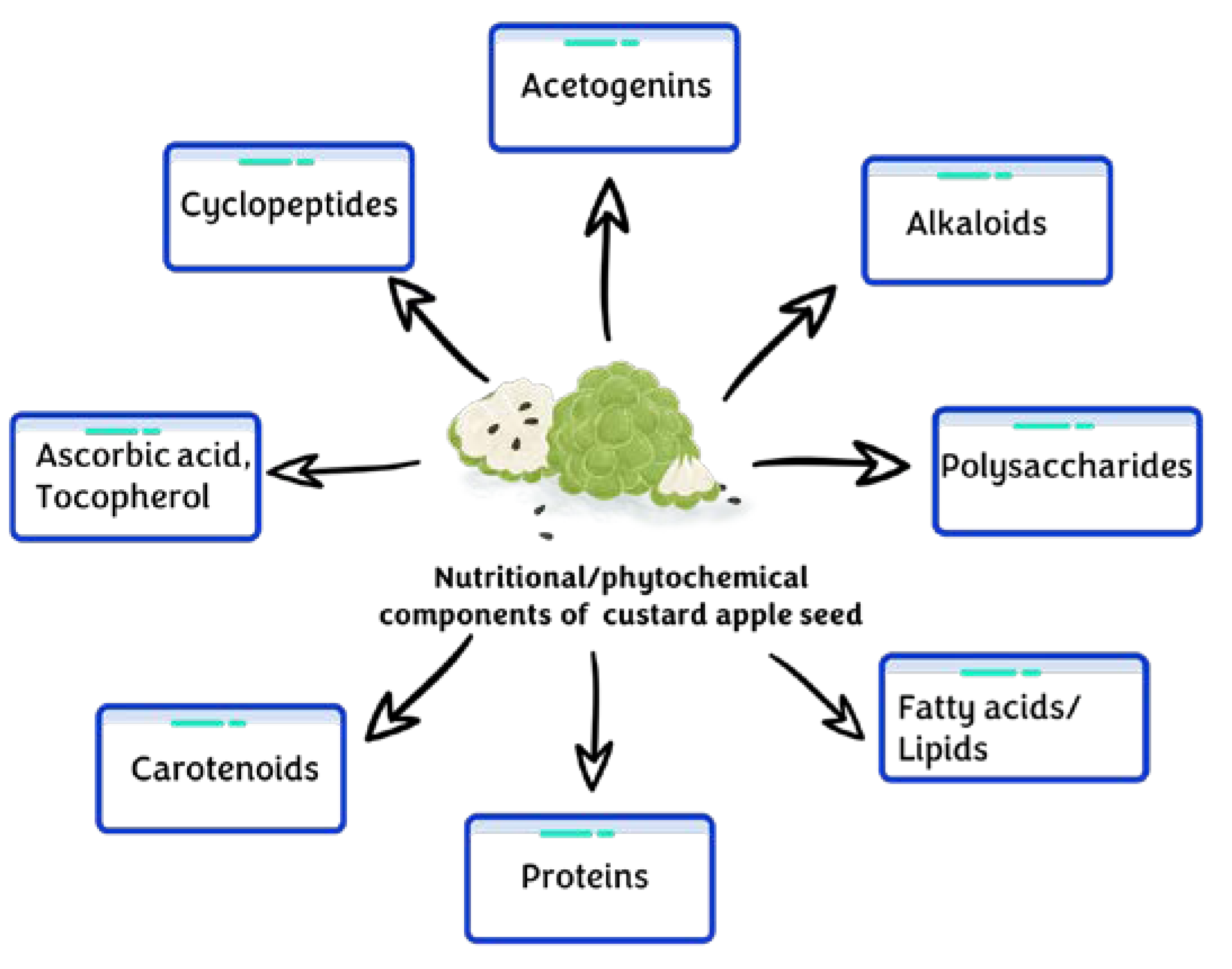
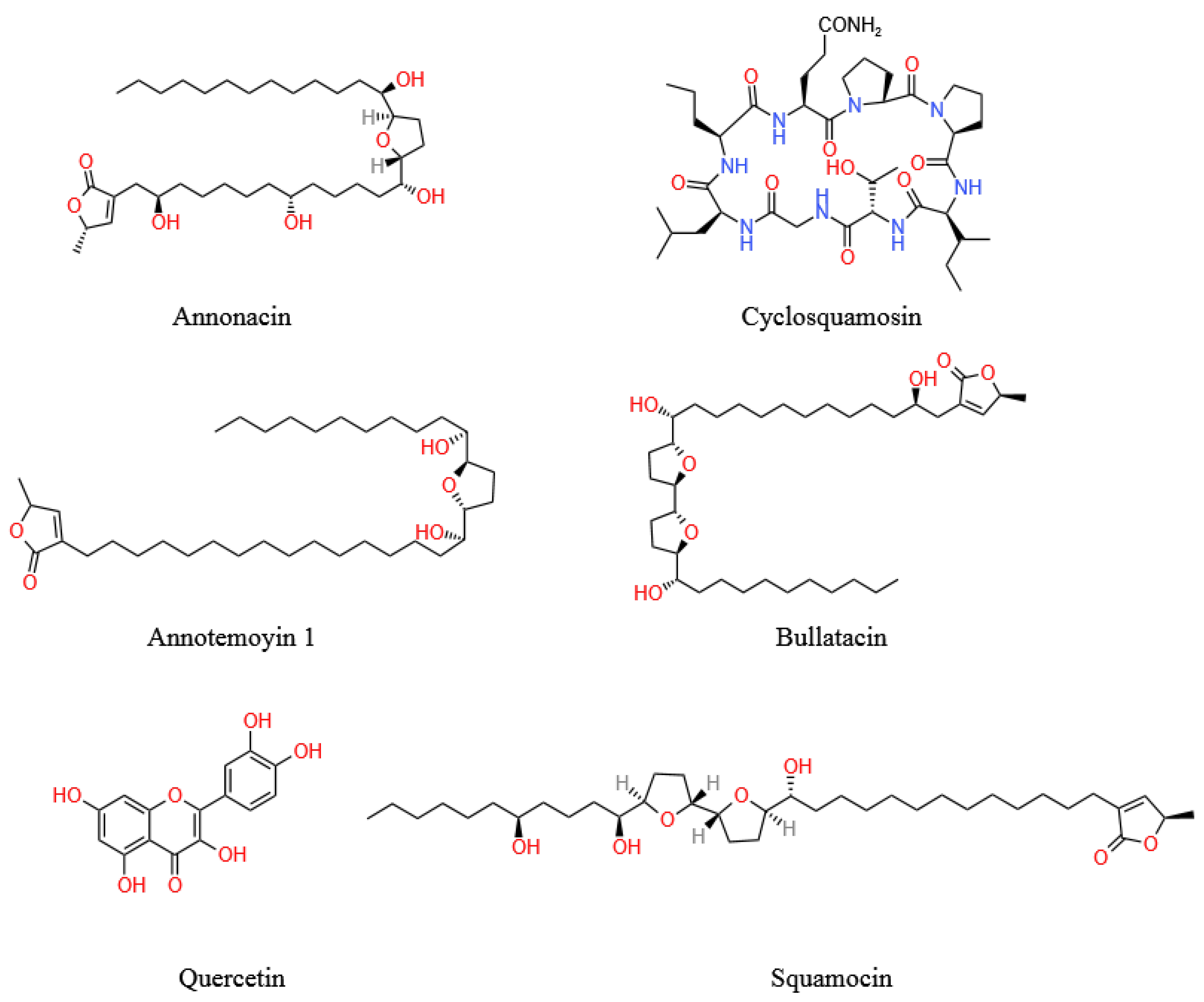
4. Pharmacological Properties
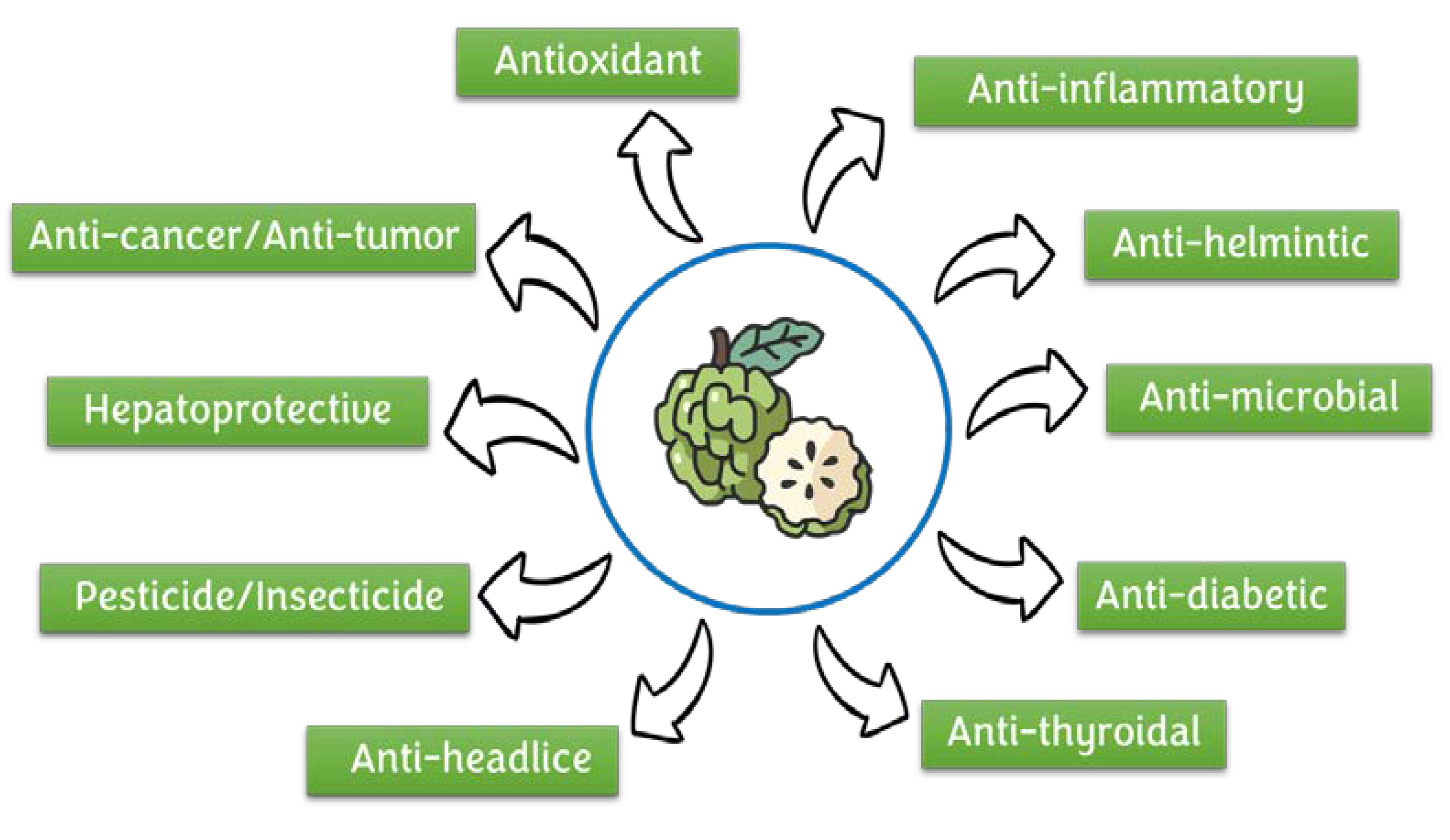
|
Variety/Region |
Activity |
Extract/Solvent Used/Concentration |
Study/Cell Line/Animal Model |
Key Finding |
Ref. |
|---|---|---|---|---|---|
|
Annona squamosa seeds (Thiruvananthapuram, Kerala state) | |||||
Crude ethanolic seed extract | |||||
- | |||||
Inhibit larval growth (20-fold) in | |||||
Spodptera litura | |||||
[ | |||||
] | |||||
[ | |||||
] | |||||
Annona squamosa | |||||
seeds (Thrissur, Kerala, India) | |||||
Larvicidal activity | |||||
Silver nanoparticles (AgNPs) of aqueous seed extract |
III and IV instars of Anopheles stephensi |
At 60 μg/mL, 100% mortality at III instar is observed. LC50 = 22.44 μg/mL; LC90 = 40.65 μg/mL at III instar stage. At IV instar LC50 = 27.83 μg/mL; LC90 = 48.92 μg/mL | |||
|
Annona squamosa seeds (Thrissur, Kerala, India) |
Antibacterial |
Silver nanoparticles (AgNPs) of aqueous seed extract |
Staphylococcus aureus, Klebsiella pnuemoniae |
Antibacterial activity of AgNPs was found to be efficient compared with plant extract and commercial antibiotic tetracycline |
ZOI—zone of inhibition; PEE—petroleum ether extract; ME—methanolic extract; CE—chloroform extract; LPS—lipopolysaccharide stimulated; DPPH—2,2-diphenyl-1-picrylhydrazyl; ABTS—2,2-azinobis (3-ethylbenzothiazoline-6-sulfonic acid) (ABTS).
References
- Kumar, M.; Changan, S.; Tomar, M.; Prajapati, U.; Saurabh, V.; Hasan, M.; Mekhemar, M. Custard apple (Annona squamosa L.) leaves: Nutritional composition, phytochemical profile, and health-promoting biological activities. Biomolecules 2021, 11, 614.
- Tamang, A.; Subba, S.K.; Chhetri, S. Wild edible and minor fruits of Odisha. Pharma Innov. J. 2021, 10, 609–613.
- Kohli, A.; Ahmad, T.; Singh, S. Aegle marmelos (Bael) and Annona squamosa (Sugar Apple). In Herbs Shrubs Trees Potential Medicinal Benefits, 1st ed.; Husen, A., Ed.; CRC Press: Boca Raton, FL, USA, 2022; pp. 339–364.
- Irwan, Z.; Kamarudin, W.F.W.; Korish, U.A.S.A.; Rusli, A.S.; Sallehuddin, S. Effectiveness of Annona squamosa and Annona muricata Seed Extracts as Ingredients in Bio-pesticides Spray. IOP Conf. Ser. Mater. Sci. Eng. 2021, 1176, 012007.
- Katole, R.M.; Sharma, M.K.; Joshi, C.K. Annona squamosa L. As a potential natural botanical pesticide and its futuristic research scope: A review. Plant Cell Biotechnol. Mol. Biol. 2021, 41–42, 75–98.
- Sundaramahalingam, M.A.; Karthikumar, S.; Kumar, R.S.; Samuel, K.J.; Shajahan, S.; Sivasubramanian, V.; Moorthy, I.G. An intensified approach for transesterification of biodiesel from Annona squamosa seed oil using ultrasound-assisted homogeneous catalysis reaction and its process optimization. Fuel 2021, 291, 120–195.
- Chiocchio, I.; Mandrone, M.; Tomasi, P.; Marincich, L.; Poli, F. Plant secondary metabolites: An opportunity for circular economy. Molecules 2021, 26, 495.
- Mondal, P.; Biswas, S.; Pal, K.; Ray, D.P. Annona squamosa as a potential botanical insecticide for agricultural domains: A review. Int. J. Bioresour. Sci. 2018, 5, 81–89.
- Ma, C.; Chen, Y.; Chen, J.; Li, X.; Chen, Y. A review on Annona squamosa L.: Phytochemicals and biological activities. Am. J. Chin. Med. 2017, 45, 933–964.
- Dai, W.; Zhang, Y.; Liu, Y.; Jiao, S.; Zhang, M. Chemical Constituents with nitric oxide inhibition from the fruit peel of Annona squamosa. Chem. Nat. Compd. 2021, 57, 1153–1156.
- Pardhasaradhi, B.V.V.; Reddy, M.; Ali, A.M.; Kumari, A.L.; Khar, A. Antitumour activity of Annona squamosa seed extracts is through the generation of free radicals and induction of apoptosis. Indian J. Biochem. Biophys. 2004, 41, 167–172.
- Chen, J.; Chen, Y.; Li, X. Beneficial aspects of custard apple (Annona squamosa L.) seeds. In Nuts and Seeds in Health and Disease Prevention, 1st ed.; Preedy, V.R., Watson, R.R., Patel, V.B., Eds.; Elsevier: London, UK, 2011; pp. 439–445.
- Poyer, S.; Laboureur, L.; Hebra, T.; Elie, N.; Van der Rest, G.; Salpin, J.Y.; Touboul, D. Dereplication of Acetogenins from Annona muricata by Combining Tandem Mass Spectrometry after Lithium and Copper Postcolumn Cationization and Molecular Networks. J. Am. Soc. Mass Spectrom. 2022, 33, 627–634.
- Fareed, M.M.; Ali, M.M. The Revelation and Therapeutic Role of Medicinal Phytochemicals in the Treatment of Cancer: A Brief. Comput. Intell. Oncol. Appl. Diagn. Progn. Ther. Cancers 2022, 1016, 335.
- Ben-Othman, S.; Jõudu, I.; Bhat, R. Bioactives from agri-food wastes: Present insights and future challenges. Molecules 2020, 25, 510.
- Ahmed, S.R.; Rabbee, M.F.; Roy, A.; Chowdhury, R.; Banik, A.; Kubra, K.; Baek, K.H. Therapeutic promises of medicinal plants in Bangladesh and their bioactive compounds against ulcers and inflammatory diseases. Plants 2021, 10, 1348.
- Imadi, S.R.; Mahmood, I.; Gul, A. Medicinal Plants Against Cancer. Plant Hum. Health 2018, 1, 139–196.
- Chen, Y.; Xu, S.S.; Chen, J.W.; Wang, Y.; Xu, H.Q.; Fan, N.B.; Li, X. Anti-tumor activity of Annona squamosa seeds extract containing annonaceous acetogenin compounds. J. Ethnopharmacol. 2012, 142, 462–466.
- Bhoir, S.S.; Vishwapathi, V.; Singh, K.K. Antipsoriatic potential of Annona squamosa seed oil: An in vitro and in vivo evaluation. Phytomedicine 2018, 54, 265–277.
- Rana, V.S. Fatty oil and fatty acid composition of Annona squamosa Linn. Seed kernels. Int. J. Fruit Sci. 2015, 15, 79–84.
- Mariod, A.A.; Elkhier, S.; Ahmed, Y.M.; Matthaus, B. Annona squamosa and Catunaregam nilotica seed, the effect of extraction method on oil composition. J. Am. Chem. Soc. 2010, 87, 763–769.
- Shehata, M.G.; Abu-Serie, M.M.; El-Aziz, A.; Mohammad, N.; El-Sohaimy, S.A. Nutritional, phytochemical, and in vitro anticancer potential of sugar apple (Annona squamosa) fruits. Sci. Rep. 2021, 11, 1–13.
- Gharibzahedi, S.M.T.; Jafari, S.M. The importance of minerals in human nutrition: Bioavailability, food fortification, processing effects and nanoencapsulation. Trends Food Sci. Technol. 2017, 62, 119–132.
- Ahvanooei, M.R.; Norouzian, M.A.; Vahmani, P. Beneficial effects of vitamins, minerals, and bioactive peptides on strengthening the immune system against COVID-19 and the role of cow’s milk in the supply of these nutrients. Biol. Trace Elem. Res. 2022, 200, 4664–4677.
- Garg, A. Role of Metal ions in Biological System. Contemp. Adv. Sci. Technol. 2022, 2, 67.
- Dare, C.A.; Oyedapo, O.O.; Akinlalu, A.O.; Komolafe, I.J.; Fajobi, A.O.; Ogunsusi, M. Genotoxic Activities of Polysaccharides from Cotyledon and Coat of Fermented and Unfermented Annona squamosa L. Seed. Egypt. Acad. J. Biol. Sci. 2021, 12, 189–207.
- Abdualrahman, M.A.Y.; Haile, M.; Cunshan, Z.; Abu, E.G.A.Y.; Ali, O.A.; Haroon, E.T.; Asif, W. Postharvest physicochemical properties of the pulp and seed oil from Annona squamosa L. (Gishta) fruit grown in Darfur region, Sudan. Arab. J. Chem. 2016, 12, 4514–4521.
- Leite, D.O.D.; Camilo, C.J.; Nonato, C.D.F.A.; Carvalho, N.K.G.D.; Salazar, G.J.T.; de Morais, S.M.; Costa, J.G.M.D. Chemical Profile and Evaluation of the Antioxidant and Anti-Acetylcholinesterase Activities of Annona squamosa L. (Annonaceae) Extracts. Foods 2021, 10, 2343.
- Kowalska, M.T.; Puett, D. Potential biomedical applications for tropical fruit products. Trop. Gard. Fruit World 1990, 1, 126–127.
- Hiwale, S. Custard apple (Annona squamosa L.). In Sustainable Horticulture in Semiarid Dry Lands; Springer: New Delhi, India, 2015; pp. 135–152.
- Zahid, M.; Arif, M.; Rahman, M.A.; Singh, K.; Mujahid, M. Solvent extraction and gas chromatography–mass spectrometry analysis of Annona squamosa L. seeds for determination of bioactives, fatty acid/fatty oil composition, and antioxidant activity. J. Diet. Suppl. 2018, 15, 613–623.
- Vetal, D.S.; Pardeshi, A.B. Insecticidal potential of ethanol and hexane solvent seed extract of Annona squamosa against Spodoptera litura Fab. J. Pharmacogn. Phytochem. 2019, 8, 842–845.
- Al-Kazman, B.S.; Harnett, J.E.; Hanrahan, J.R. The Phytochemical Constituents and Pharmacological Activities of Annona atemoya: A Systematic Review. Pharmaceuticals 2020, 13, 269.
- Pathak, J.; Patel, P.K.; Suthar, R.; Shah, K.R. Identification of Phytochemicals from seed extract of Custard Apple (Annona squamosa L.). Biosci. Biotechnol. Res. Commun. 2021, 14, 397–402.
- Mangal, M.; Khan, M.I.; Agarwal, S.M. Acetogenins as Potential Anticancer Agents. Anticancer Agent. Med. Chem. 2015, 16, 138–159.
- Ribeiro, L.P.; Zanardi, O.Z.; Gonçalves, G.; Ansante, T.F.; Yamamoto, P.T.; Vendramim, J.D. Toxicity of an Annonin-Based Commercial Bioinsecticide Against Three Primary Pest Species of Stored Products. Neotrop. Entomol. 2018, 47, 145–151.
- Nugraha, A.S.; Damayanti, Y.D.; Wangchuk, P.; Keller, P.A. Anti-infective and anti-cancer properties of the Annona species: Their ethno medicinal uses, alkaloid diversity, and pharmacological activities. Molecules 2019, 24, 4419.
- Thangaraj, V.; Khan, M.R.; Rajendran, A.; Selvam, D. Phytochemical Screening of Annona squamosa (L.) Seed Extracts: A Potential Source of Ethnomedicine. Indo Am. J. Pharm. Res. 2017, 7, 8068–8072.
- Nguyen, V.; Nguyen, Q.; Muoi, N.; Mai, C. Effect of Extraction Conditions on Total Polyphenol and Flavonoid Content of Sugar Apple Seeds (Annona squamosa L.). Asian. J. Chem. 2020, 32, 1741–1745.
- Kumar, Y. New compound 6, 7-dimethoxy-2-methylisoquinolinium from Indian medicinal plant Annona squamosa L. Int. J. Chem. Anal. Sci. 2013, 4, 161–168.
- Ravaomanarivo, L.H.R.; Razafindraleva, H.A.; Raharimalala, F.N.; Rasoahantaveloniaina, B.; Ravelonandro, P.H.; Mavingui, P. Efficacy of seed extracts of Annona squamosa and Annona muricata (Annonaceae) for the control of Aedes albopictus and Culex quinquefasciatus (Culicidae). Asian Pac. J. Trop. Biomed. 2014, 4, 798–806.
- Janicke, B.; Hegardt, C.; Krogh, M.; Önning, G.; Åkesson, B.; Cirenajwis, H.M.; Oredsson, S.M. The antiproliferative effect of dietary fiber phenolic compounds ferulic acid and p-coumaric acid on the cell cycle of Caco-2 cells. Nutr. Cancer. 2011, 63, 611–622.
- Pei, K.; Ou, J.; Huang, J.; Ou, S. p-Coumaric acid and its conjugates: Dietary sources, pharmacokinetic properties and biological activities. J. Sci. Food Agric. 2016, 96, 2952–2962.
- Vikas, B.S.; Malar, J.P.W.; Remani, P. Antibacterial activity of Annona squamosa seed extract. Int. J. Pharm. Technol. 2013, 5, 5651–5659.
- Aher, P.S.; Shinde, Y.S.; Chavan, P.P. In vitro evaluation of antibacterial potential of Annona squamosa L. against pathogenic bacteria. Int. J. Pharm. Sci. Res. 2012, 3, 1457.
- Aamir, J.; Kumari, A.; Khan, M.N.; Medam, S.K. Evaluation of the combinational antimicrobial effect of Annona squamosa and Phoenix dactylifera seeds methanolic extract on standard microbial strains. Int. Res. J. Biol. Sci. 2013, 2, 68–73.
- Baranwal, A.; Arora, S.; Kumar, R.G.; Praharsha, J.; Javed, A.; Sanobar, N. Evaluation of the combinational antimicrobial effect of Prunus persia and Annona squamosa seeds methanolic extract on standard microbial strains. Glob. J. Biosci. Biotechnol. 2013, 2, 571–575.
- Singh, P.; Singh, K.R.; Singh, J.; Das, S.N.; Singh, R.P. Tunable electrochemistry and efficient antibacterial activity of plant-mediated copper oxide nanoparticles synthesized by Annona squamosa seed extract for agricultural utility. RSC Adv. 2021, 11, 18050–18060.
- Dang, Q.L.; Kim, W.K.; Nguyen, C.M.; Choi, Y.H.; Choi, G.J.; Jang, K.S.; Kim, J.C. Nematicidal and antifungal activities of annonaceous acetogenins from Annona squamosa against various plant pathogens. J. Agric. Food Chem. 2011, 59, 11160–11167.
- Sangala, R.; Kodati, D.R.; Burra, S.; Gopu, J.; Dubasi, A. Evaluation of antidiabetic activity of Annona squamosa Linn Seed in alloxan–induced diabetic rats. Diabetes 2011, 2, 100–106.
- Dellai, A.; Maricic, I.; Kumar, V.; Arutyunyan, S.; Bouraoui, A.; Nefzi, A. Parallel synthesis and anti-inflammatory activity of cyclic peptides cyclosquamosin D and Met-cherimolacyclopeptide B and their analogs. Bioorg. Med. Chem. Lett. 2010, 20, 5653–5657.
- Yang, Y.L.; Hua, K.F.; Chuang, P.H.; Wu, S.H.; Wu, K.Y.; Chang, F.R.; Wu, Y.C. New cyclic peptides from the seeds of Annona squamosa L. and their anti-inflammatory activities. J. Agric. Food Chem. 2008, 56, 386–392.
- Chen, Y.; Chen, Y.; Shi, Y.; Ma, C.; Wang, X.; Li, Y.; Li, X. Antitumor activity of Annona squamosa seed oil. J. Ethnopharmacol. 2016, 193, 362–367.
- Liaw, C.C.; Yang, Y.L.; Chen, M.; Chang, F.R.; Chen, S.L.; Wu, S.H.; Wu, Y.C. Mono-tetrahydrofuran annonaceous acetogenins from Annona squamosa as cytotoxic agents and calcium ion chelators. J. Nat. Prod. 2008, 71, 764–771.
- Ao, H.; Lu, L.; Li, M.; Han, M.; Guo, Y.; Wang, X. Enhanced Solubility and Antitumor Activity of Annona squamosa Seed Oil via Nanoparticles Stabilized with TPGS: Preparation and In Vitro and In Vivo Evaluation. Pharmaceutics 2022, 14, 1232.
- Sneeha, V.; Safreen, S.D.A.; Kumaresan, R. Anti-cancer efficacy of ethanolic extracts from various parts of Annona Squamosa on MCF-7 cell line. J. Pharmacogn. Phyther. 2016, 8, 147–154.
- Kothari, V.; Seshadri, S. Antioxidant activity of seed extracts of Annona squamosa and Carica papaya. Nutr. Food Sci. 2010, 40, 403–408.
- Luzia, D.M.M.; Jorge, N. Soursop (Annona muricata L.) and sugar apple (Annona squamosa L.): Antioxidant activity, fatty acids profile and determination of tocopherols. Nut. Food Sci. 2012, 42, 434–441.
- Mehta, S.D.; Paliwal, S. Hepatoprotective activity of hydroalcohilic extract of Annona squamosa seeds. Int. J. Pharmacol. Phytol. Res. 2017, 9, 997–1000.
- Panda, S.; Kar, A. Annona squamosa seed extract in the regulation of hyperthyroidism and lipid-peroxidation in mice: Possible involvement of quercetin. Phytomedicine 2007, 14, 799–805.
- Morita, H.; Iizuka, T.; Choo, C.Y.; Chan, K.L.; Takeya, K.; Kobayashi, J.I. Vasorelaxant activity of cyclic peptide, cyclosquamosin B, from Annona squamosa. Bioorg. Med. Chem. Lett. 2006, 16, 4609–4611.
- Srivastava, S.; Lal, V.K.; Pant, K.K. Medicinal potential of Annona squamosa: At a glance. J. Pharmacol. Res. 2011, 4, 4596–4598.
- Intaranongpai, J.; Chavasiri, W.; Gritsanapan, W. Anti-head lice effect of Annona squamosa seeds. Southeast Asian J. Trop. Med. Public Health 2006, 37, 532.
- Srilakshmi, S.; Sravanthi, K.C.; Sarvani, M.; Krishnaharsha, A.; Karteek, P. Anti-helminthic activity of Annona squamosa seed extract. Int. J. Pharm. Technol. 2011, 3, 1623–1628.
- Souza, M.; Bevilaqua, C.M.; Morais, S.M.; Costa, C.T.; Silva, A.R.; Braz-Filho, R. Anthelmintic acetogenin from Annona squamosa L. Seeds. An. Acad. Bras. Ciênc. 2007, 80, 271–277.
- Leatemia, J.A.; Isman, M.B. Insecticidal activity of crude seed extracts of Annona spp., Lansium domesticum and Sandoricum koetjape against lepidopteran larvae. Phytoparasitica 2004, 32, 30–37.
- Jose, V.; Raphel, L.; Aiswariya, K.S.; Mathew, P. Green synthesis of silver nanoparticles using Annona squamosa L. seed extract: Characterization, photocatalytic and biological activity assay. Bioprocess Biosyst Eng. 2021, 44, 1819–1829.
